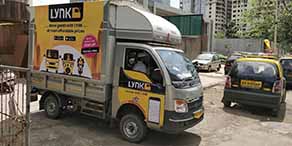Story and Photo by Deven Lad
The erstwhile bankable Small Commercial Vehicles segment witnesses a consumption-led slowdown in H1 FY 2019.
Higher fuel costs, lower truck rentals, weak freight availability, disruptive tech and stiffer competition have made it harder for small truck operators to stay in business. Take the story of 47-year-old Dinesh Kamble. Operating in the small truck business for over two decades, he owns the Tata Ace Mega. Of the opinion that competition has risen tremendously over the years and burdened by a high cost of ownership, he gives a reason to believe that the undercurrent has a key role to play in demand for Small Commercial Vehicles (SCVs), spanning up to Gross Vehicle Weight (GVW) of 3.5-tonnes declining. Quipped Kamble, “In early times, the competition was not this tough. Today most small companies have shut down and as a result, others have turned cost-conscious.” “In the industrial area, some companies are buying small trucks by pooling together which in turn has impacted business,” he explained. In another trend, Kamble drew attention to the stiff competition being faced by small truck operators like himself, from the new breed of small private operators that have mushroomed in the same locality where consignees previously relied on a single transporter to meet all their demands.
Adding to the woes is the high Total Cost of Ownership (TCO) where fuel accounts for an estimated 50-70 per cent of the total operational costs. For instance, diesel on an average is priced at Rs. 68.42 a litre and is no longer considered to be the transporters’ fuel of choice. “ It has always been a worrisome factor because operational expenses are turning higher than the actual earned income,” said Kamble. Echoing a similar sentiment was also trucker, Umesh Prasad. Prasad drew attention to other operational costs like EMI, insurance, traffic fines, and daily maintenance which he claims have increased over the recent months. “I get Rs.20,000 after working hard for the entire month and then I have to pay EMI of Rs.10,000 rupees. Now with the remaining Rs.10,000, I have to share half of it with my wife (Rs.5000) and go through with the rest of the month with the remaining half (Rs.5000). Prasad also drew attention to the new, higher fines as per the Motor Vehicle (Amendment) Act – 2019. “I follow traffic rules but there is too much aggression towards small trucks on the road with fines to the tune of Rs.8000. Tell me, how can a small businessman like me afford such a high fine,” he questioned. The 34-year-old businessman talked of being compelled to look at the option of quitting the business if such uncertainty and high cost of operations prevail in times to come. That apart, a report by the Indian Foundation of Transport Research and Training claims that truck rentals have witnessed a steep fall of 15-17 per cent in the past 10 months, higher than the 12-13 per cent fall in the 2008-09 global crisis. Truckers, despite a four per cent rise in diesel prices since January this year, are known to have been unable to pass on the added operational cost to the end consumer.
After the steep fall witnessed in the sales of Medium and Heavy Commercial Vehicles by industry, the Small Commercial Vehicles (SCV) segment was expected to help manufacturers tide along especially given the demand for last-mile transportation. It is worrisome that SCVs are facing the heat of the overall slowdown in the economy too. Like the other commercial vehicles segments, the SCV segment is not insulated from degrowth either as also indicated by small scale businessman like Kamble and Prasad above. From charting a buoyant growth path in FY2019 that saw the sector growing at 42 per cent growth rate, the SCV segment is known to be weighed down by the overall slowdown in the first quarter of FY2019 (Q1 FY2019) itself. Averred Rajan Wadhera, President, SIAM at the 59th SIAM Annual Convention, in Delhi, “In some segments, I agree that it must be inventory correction but very largely in the commercial vehicle segment, which is a mirror of the economy, the economy is slowing down with a genuine loss of sales.” As per the SIAM data, the larger universe of Light Commercial Vehicles (LCVs) of which SCVs are a subset of, declined by (-) 5.06 per cent in April-June 2019 over the same period last year. The passenger carrier sales declined by (-) 2.19 per cent with the goods carrier sales declining by (-) 5.43 per cent. In the same period, the overall CV segment registered a sales decline of (-) 9.53 per cent corresponding to the same period last year. As per Information and Credit Rating Agency of India (ICRA), the overall outlook for the CV sector (for FY2020) remains muted setting aside the hopes for a revival in the SCV segment. It also hints at caution in forecasting growth ahead of the industry’s transition to Bharat Stage VI on April 01, 2020, day one of the next financial year (FY2021).
As per SIAM data, the segment leader, Tata Motors registered an 11.42 per cent growth in passenger carrier segment and a (-) 10.34 per cent decline in the goods carrier segment for the period April-June, 2019. In contrast, the company in FY2019 sold 1.56 lakh units of Tata Ace in market size estimated to be of 2.35 lakh units. By doing so the company accounted for a 67 per cent market share. The phenomenal run was aided by the 42 per cent growth of the SCV segment. Averred Girish Wagh, “The fortunes of the SCV segment are closely linked to consumption. While the growth rate of the segment tapered down in the second half of FY2019, the consumption in the country is set to grow from a long-term perspective, making the segment an important pillar of growth.” Wagh cited the example of developed markets where four small commercial vehicles are sold for one medium and heavy commercial vehicle sold. In India, the ratio is known to be 1:2 leaving room for the segment to grow, he opined. Compared to Tata Motors, Ashok Leyland registered an 8.99 per cent growth in the sales of passenger carriers light commercial vehicles and a 6.96 per cent growth in the sales of goods carriers light commercial vehicles. In the same segment, Mahindra & Mahindra registered a (-) 20.20 per cent decline in sales of passenger carriers and a (-) 7.44 per cent fall in goods carrier sales. Force Motors registered a (-) 6.34 per cent decline in passenger carrier sales and a 15.55 per cent growth in goods carrier sales. Piaggio Vehicles registered a (-) 67.67 per cent decline in goods carrier sales. Maruti Suzuki India Pvt. Ltd., registered a growth of 34.78 per cent growth in goods carrier sales.
A slowdown is not new for transporters. Many have been in the business for over two decades. However disruptive technology is. Referring to the app-based startups like Porter, Blackbuck, Lynk, and trucky among other such platforms, Ganesh Kate who owns an Ashok Leyland Dost truck, expressed concerns over the disruptive aggregator business models changing the metrics of the business. “These apps have killed my business. If it continues, I could be forced out of the sector post the festive season by November,” he expressed concern. “Apps like Porter have killed most of the market, the old days were better but now it’s a do or die situation. Either you join them or risk being unemployed,” he said. Kate opined that the new stream of transport applications were better suited to newer entrants and not the old generation of businessmen who were relatively content serving their loyal set of customers instead. In contrast to Kate, there were others who cited the growing need of the customer to be serviced online as a reason for the tech-fueled startups’ upward trajectory.
While small truck operators fight their own battles, manufacturers have their tasks cut out too. To create a ‘pull’ for their SCVs in the market. Besides seeking government intervention to revive the sector, they are also banking on meeting customer expectations. Offering best-in-class payload capacity, loading space, fuel efficiency with emission standards like BSVI, superior ergonomics, driver comfort and safety, ac-cabins, power steering, the low total cost of ownership and a robust aftermarket network are some of the focus areas to win back the SCV customer.


























